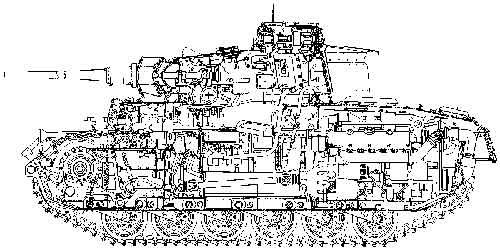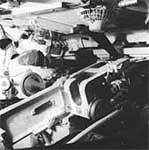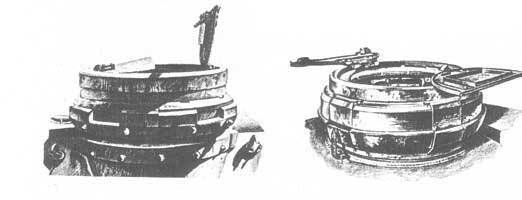/Vehicles/Axis/Germany/02-mPanzers/PzKpfw3/File/2-Design.htm | Up-dated:
Panzerkampfwagen III Medium Tank
Design: Front Compartment
Le compartiment avant du Panzer III renfermait les ensembles de transmission et de commande finale ainsi que les sièges du pilote et du radio-mitrailleur Les parois du bas de caisse (caisse inférieure) et de la superstructure (caisse supérieure) étaient entièrement situées entre les 2 trains de chenille ce qui procurait un largeur interne parfaitement uniforme, limitant ainsi l'espace intérieur.
The front compartmentof of Panzer III contained the sets of transmission and final command as well as the seats of the pilot and the radio-machine gunner. The walls of the lower hull and of the superstructure (upper hull) were entirely located between the 2 sets of tracks which got a interior width perfectly uniform, thus limiting interior space.
 |
Panzer III
Ausf.F interior details |
src: Connaissance de l'Histoire (Hachette),
n°17
|
La boîte de vitesse avec présélecteur "Variorex" était très efficace sur ses sept premières vitesses. Au delà, l'effort tractif chutait brusquement. Si la huitième vitesse convenait encore pour les voyages sur route, les neuvième et dixième vitesses ont étaient rarement utilisées, considérées comme dépassées. La boîte de vitesse Aphon synchromesh disposait d'une réputation favorable, bien que la puissance de traction de sixième vitesse était basse, réservée pour la route. Lorsque le pilote rencontrait un relief moins favorable ou devait changer de direction, il lui était recommandé de descendre de deux vitesses en dessous de celle enclenchée. La commande finale et l'ensemble de frein de direction étaient extrêmement (trop) compliqués. Un soin important a été pris pour fournir un système de ventilation pour les tambours de frein. Néanmoins, il n'y avait aucune égalisation automatique du couple sur les deux axes de rendement, et le mécanisme ne fournissait pas de direction positive quand les deux freins de direction étaient libérés.
Des cartouchières en toile (150 coups) pour les mitrailleuses étaient disposés le long des parois des compartiments avant et central. Ce système de sac était moins efficace que la boîte en métal utilisé par les Britanniques car une main était monopolisée pour favoriser le passage de la ceinture dans l'arme. Cela avait pour conséquence, que lorsque que le radio-mitrailleur manipulait son arme au moyen de de la crosse, l'élévation et la traverse en était grandement limitées. Pour résoudre se problème, un chapeau en caoutchouc moulé, couplé à la mitrailleuse par une barre, fut installé. Il suffisait au gunner de soulever ou abaisser sa tête pour obtenir soit la dépression, soit l'altitude.
The gear box with preselector, "Variorex" was very effective on its the first seven speeds. Beyond that, the tractive effort fell abruptly. If the eighth speed were still appropriate for the transits on road, the ninth and the tenth speeds have were seldom used, regarded as obsolete. The gear box Aphon synchromesh had a reputation favorable, although the power of traction the sixth speed low, was reserved for the road. When the pilot met a less favorable relief or was to change direction, it was recommended to him to go down from two speeds below that engaged. The final command and the whole of steering brake were extremely (too much) complicated. A significant care was taken to provide a system of ventilation for the brake drums. Nevertheless, there was no automatic equalization of the couple on the two axes of output, and the mechanism did not provide positive direction when the two steering brakes were released.
Cartridge pouches in fabric (150 rounds) for the machine-guns were laid out along the walls of the front and central compartments. This system of bag was less effective than the metal box used by the British because a hand was monopolized to support the passage of the belt in the weapon. For consequence, when that the radio-machine gunner handled his weapon by means of stick, elevation and the traverse was largely limited by it. To solve problem, moulded rubber hat, coupled with the machine-gun by a bar, was installed. It was enough to the gunner to raise or lower his head to obtain either the depression, or altitude.
 |
Les Panzers III utilisèrent
deux types de montage sur rotule pour leur MG34 de caisse: à gauche: Kugelblende 30 (blindage de 30mm) pour MG34 monté sur les modèles E-H à droite: Kugelblende 50(blindage de 50mm) pour MG34 monté sur les modèles J-N |
Panzers
III used two types of ball mount for their MG34 of hull: on the left: Kugelblende 30 (armor of 30mm) for MG34 assembled on the E-H models on the right: Kugelblende 50(armor of 50mm) for MG34 assembled on the J-N models |
src: Pz.Kpfw III in action, Armor Number 24
(squadron/signal publications, inc.)
|
Le conducteur disposait d'une fenêtre de conduite en verre blindé protégés par un volet blindé qui était verrouillé dans l'action. Une paire de jumelles périscopiques, dont les deux trous étaient évidents au-dessus de la fenêtre, permettait d'assurer la vision du pilote en situation de combat. Deux sabords de vision étaient également montés sur les côtés de la superstructure pour le pilote et le radio-mitrailleur.
The driver had a window of control with armoured glass protected by an armoured shutter which was locked in the action. A pair of periscopic binoculars, whose two holes were obvious above the window, made it possible to ensure the vision of the pilot in situation of combat. Two ports of vision were also assembled on the sides of the superstructure for the pilot and the radio-machine gunner.
Le compartiment central ou de combat du Panzer III était composé d'un plancher fixe (non rattaché à la tourelle) et était séparé du compartiment moteur par un mur pare-feu. L'arbre de transmission le parcourait sur toute sa longueur vers la commande finale. Ce compartiment accueillait le siège du chargeur. Cette disposition était gênante pour ce dernier en effet il devait se déplacer en fonction de la position de la tourelle au contraire du gunner et du commandant dont les sièges étaient attachésà celle-ci. Dans la partie basses sur les cloisons latérales se trouvaient deux portes montées sur charnières servant à l'accès du char.
The central or combat compartment of Panzer III was composed of a fixed floor (not attached to the turret) and was separated from the engine compartment by a anti-fire wall. The driveshaft traversed it over all its length towards the final command. This compartment accomodated the seat of the loader. This disposition was awkward for this last indeed he was to move according to the position of the turret on the contrary gunner and the commander whose seats were mounted in this last. In the lower parts on the side walls, two doors assembled on hinges were being used for the access of the tank.
 |
Panzer III
Ausf.J interior details |
src: Connaissance
de l'Histoire (Hachette), n°17 |
Pour les véhicules armés du canon de 50mm KwK L/42 la disposition des munitions se faisait comme suit:
- 5 coups sous le siège du gunner
- 22 coups dans un casier situé dans le coin arrière-droit du compartiment
- 12 coups dans un casier situé au-dessus de ce dernier
- 36 coups dans un casier situé dans le coin arrière-gauche du compartiment
- 24 coups dans un casier situé au-dessus de ce dernier
Ce qui nous fait un total de 99 coups emportés.
A l'extérieur du compartiment de combat (à droite) se trouvait l'antenne-radio montée sur une base pivotant qui permettait de ranger celle-ci en position horizontale entre deux-rails lorsqu'elle n'était pas utilisée.
For the vehicles armed with the
gun of 50mm KwK L/42 the provision of the ammunition was done as follows:
- 5 rounds under the seat of the gunner
- 22 rounds in a rack located in the back-right corner of the compartment
- 12 rounds in a rack located above this last
- 36 rounds in a rack located in the back-left corner of the compartment
- 24 rounds in a rack located above this last
What makes us a total of 99 stored rounds.
At the outside of the compartment of combat (on the right) was the antenna-radio mounted on a swivelling basis which made it possible to arrange this one in horizontal position between two-rails when it was not used.
 |
Hull escape hatch |
L'élévation du canon (et de la MG34) se faisait au moyen d'un volant actionné de la main gauche par le gunner (assis à la gauche de la culasse. A sa droite se trouvait volant de traverse. Un verrou de dégagement couplé à une manivelle sous le canon permettait au chargeur de prêter main forte au gunner. Le mécanisme transversal comportait deux vitesses, l'une nécessitant 88 tours du volant (révolution complète) et l'autre 132 tours.
The elevation of the gun (and the MG34) was done by means of a wheel actuated by the left hand of the gunner (sitted on the left of the cylinder head. On its right, wheel of traverse was. A bolt of release coupled to a crank under the gun made it possible to the loader to lend strong hand to the gunner. The traverse mechanism comprised two speeds, one requiring 88 turns of the wheel (complete revolution) and the other 132 turns.
 |
Internal view of the turret of
the Panzer III Ausf.F. |
src: Connaissance de l'Histoire (Hachette),
n°17
|
Le canon était mis à feu électriquement et son recul était compensé par un système d'amortisseur hydropneumatique. Les pistolets de 50mm avaient le museau lourd dans leur affût. Ce défaut sur le KwK L/42 était compensé par l'addition d'un contrepoids derrière le bouclier. Cependant, sur le KwK L/60 (canon long), le déséquilibre était bien plus prononcé et un petit ressort de compression installé dans un cylindre a été monté sur le coin avant-gauche de l'anneau de tourelle et fixé au canon à partir de l'Ausf. J. Sur les modèles précédents, une barre de torsion était boulonnée au toit et relié à la partie supérieure de l'affût. Jusqu'au modèle G, le Panzer III fut armé du canon de 37mm KwK L/45 vite jugé trop faible pour un char de combat. Les modèles suivants ainsi que rétrospectivement les modèles E/F/G seront armés avec le plus puissant canon de 50mm KwK L/42 à canon court. Le canon de 50mm KwK L/60 à canon long sera installé dès le modèle J (et rétrospectivement sur le H). A part le modèle N armé du canon de 75mm KwK L/24 à faible vitesse initiale tous les modèles ultérieurs seront équipés de ce canon. Le 50mm KwK L/60 tirait des munitions perforantes à haute vitesse initiale (1182m/s).
The gun was fired electrically and its recoil was compensated by a system of hydropneumatic shock absorber. The guns of 50mm had the heavy muzzle in their mounting. This defect on KwK L/42 was compensated by the addition of a counterweight behind the shield. However, on KwK L/60 (long gun), imbalance was much more marked and a small spring of compression installed in a cylinder was assembled on the front-left corner of the ring of turret and was fixed at the gun starting from Ausf. J On the preceding models, a bar of torsion was bolted with the roof and connected to the higher part of the mounting. Until the model G, Panzer III was armed with the gun of 37mm KwK L/45 quickly considered to be too weak for a tank. The following models as retrospectively models E/F/G will be armed with the most powerful gun with 50mm KwK L/42 with short gun. The gun of 50mm KwK L/60 with long gun will be installed as of the model J (and retrospectively on H). Separately model N armed with the gun of 75mm KwK L/24 at low initial speed all the later models will be equipped with this gun. The 50mm KwK L/60 drew from the perforating ammunition at high initial speed (1182m/s).
37
mm KwK L/46.5 Penetration of a shielding plate (mm) under a plunging angle of 30° |
|||||||
Ammo |
Weight |
Velocity |
100
m |
500 m |
1000
m |
1500 m |
2000
m |
| PzGr 40 | 0.368 kg |
1020 m/s |
34 |
29 |
22 |
19 |
- |
50
mm KwK 38 L/42 Penetration of a shielding plate (mm) under a plunging angle of 30° |
|||||||
Ammo |
Weight |
Velocity |
100
m |
500 m |
1000
m |
1500 m |
2000
m |
| PzGr 39 | 2.060 kg |
685 m/s |
54 |
46 |
36 |
28 |
22 |
| PzGr 40 | 0.925 kg |
1060 m/s |
96 |
58 |
- |
- |
- |
50
mm KwK 36 L/60 Penetration of a shielding plate (mm) under a plunging angle of 30° |
|||||||
Ammo |
Weight |
Velocity |
100
m |
500 m |
1000
m |
1500 m |
2000
m |
| PzGr 39 | 2.060 kg |
835 m/s |
69 |
59 |
48 |
38 |
29 |
| PzGr 40 | 0.925 kg |
1180 m/s |
130 |
72 |
38 |
- |
- |
75
mm KwK 37 L/24 Penetration of a shielding plate (mm) under a plunging angle of 30° |
|||||||
Ammo |
Weight |
Velocity |
100
m |
500 m |
1000
m |
1500 m |
2000
m |
| K Gr rot Pz | 6.8 kg |
385 m/s |
41 |
39 |
35 |
33 |
30 |
| Gr 38 H1/A | 4.4 kg |
450 m/s |
70 |
39 |
35 |
33 |
30 |
| Gr 38 H1/B | 4.57 kg |
450 m/s |
75 |
39 |
35 |
33 |
30 |
Gr 38 H1/C |
4.80 kg |
450 m/s |
100 |
39 |
35 |
33 |
30 |
La lunette de visée (TZF5 a/d/E) était assez complexe. La première partie (portée) tournait sur son axe, les graduations du canon et de la mitrailleuse étaient marquées sur les quarts de cercle opposés - les graduations étaient comprises entre 0 et 2000 mètres pour le canon de 50mm, et pour la mitrailleuse de 0 à 800 mètres. La seconde partie (obtention de cible) pivotait sur un plan vertical et comprenait les marques de visée. Ces deux parties se déplaçaient simultanément.
The sight tube (TZF5 a/d/E) was rather complex. The first part (range) turned on its axis, the graduations of the gun and the machine-gun were marked on the opposite quadrants - the graduations lay between 0 and 2000 meters for the gun of 50mm, and the machine-gun from 0 to 800 meters. The second part (target) swivelled on a vertical level and included the marks of aiming. These two parts moved simultaneously.
 |
 |
 |
Panzer III Ausf.J
turret |
||
Le commandant et assis derrière le gunner. Notons que leurs sièges ont été attachés directement à la tourelle. La coupole du commandant comprenait des obturateurs blindés qui pourraient être verrouillés en positions ouverte, intermédiaire ou fermée pour protéger les blocs de vision en verre blindé. Dans certaines coupoles, les commandants firent peindre le cadrant d'une horloge pour connaître la position de la tourelle par rapport à la coque, ce qui pouvait être difficile en plein combat. La tourelle comprenait encore deux portes (à unique ou double montants) sur les côtés arrière, ainsi qu'un extracteur de fumée dont on aperçoit le capuchon sur le toit et un coffre de rangement à l'arrière. Des ports de tir aux pistolets sont également visibles sur les portes (montant arrière) et à l'arrière de la tourelle. Pour compléter la vision deux sabords sont présents sur les côtés avant de la tourelle et sur les portes. Sur les modèles tardifs des lances-grenades fumigènes seront installés sur la partie avant des côtés de la tourelle à raison de 3 par côtés.
The commander was sitted behind the gunner. Let us note that their seats were attached directly to the turret. The cupola of the commander included armoured obturators which could be locked in positions opened, intermediate or closed to protect the vision blocks in armoured glass. In certain cupolas, the commanders made paint it tallying of a clock to know the position of the turret compared to the hull, which could be difficult in full combat. The turret included more two doors (with single or double parts) on the sides rear parts, as well as an extractor of smoke which one sees the cap on the roof and a trunk of arrangement to the back. Ports of shooting to the pistols are also visible on the doors (back part) and on the back of the turret. To supplement the vision two ports are present on the front-sides turret and on the doors. On the late models smoke-grenades mortars will be installed on the front-part of the sides of the turret at a rate of 3 per sides.
 |
à gauche: coupole de commandant
montée sur les modèles G-N à droite: coupole de commandant montée sur les modèles E-F |
on the left:
cupola of commander mounted on the G-N models on the right: cupola of commander mounted on the E-F models |
src: Connaissance
de l'Histoire (Hachette), n°17 |
Sources:
- Pz.Kpfw III in action, Armor Number 24 (squadron/signal publications, inc.)
- Connaissance de l'Histoire (Hachette) - N°17 - " Les chars de combat allemands 39-45"
- Connaissance de l'Histoire (Hachette) - N°5 - " Véhicules blindés allemands 39-45"
- Les Blindés de la Seconde Guerre Mondiale (Atlas)
- Panzerkampfwagen III Medium Tank 1936-1944 (Osprey Military) - New Vanguard N°27
- Site "Achtung Panzer" - http://www.achtungpanzer.com
- Site "Germany's vehicle history" - http://www.wwiivehicles.com
- Site "Second World War Armour" - http://www.onwar.com/tanks/index.htm